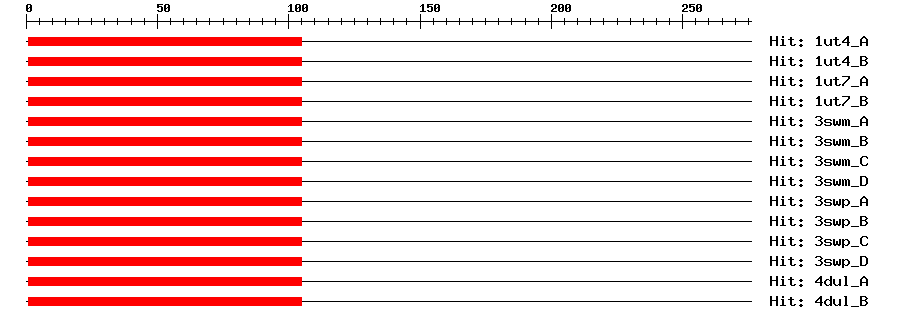| Signature Domain? help Back to Top |
 |
| No. |
Domain |
Score |
E-value |
Start |
End |
HMM Start |
HMM End |
| 1 | NAM | 105.8 | 5.3e-33 | 4 | 79 | 53 | 129 |
NAM 53 aeekewyfFskrdkkyatgkrknratksgyWkatgkdkevlskkgelvglkktLvfykgrapkgektdWvmheyrle 129
+ekewyfF rd+ky+tg r+nrat++gyWk+tgkdke+++ g lvg+kktLvfykgrapkgek++Wvmheyrle
orange1.1g036376m 4 MGEKEWYFFNLRDRKYPTGLRTNRATEAGYWKTTGKDKEIFR-AGVLVGMKKTLVFYKGRAPKGEKSNWVMHEYRLE 79
5789**************************************.999*****************************85 PP
|
| 3D Structure ? help Back to Top |
 |
| PDB ID |
Evalue |
Query Start |
Query End |
Hit Start |
Hit End |
Description |
| 1ut4_A | 6e-35 | 1 | 105 | 65 | 171 | NO APICAL MERISTEM PROTEIN |
| 1ut4_B | 6e-35 | 1 | 105 | 65 | 171 | NO APICAL MERISTEM PROTEIN |
| 1ut7_A | 6e-35 | 1 | 105 | 65 | 171 | NO APICAL MERISTEM PROTEIN |
| 1ut7_B | 6e-35 | 1 | 105 | 65 | 171 | NO APICAL MERISTEM PROTEIN |
| 3swm_A | 6e-35 | 1 | 105 | 68 | 174 | NAC domain-containing protein 19 |
| 3swm_B | 6e-35 | 1 | 105 | 68 | 174 | NAC domain-containing protein 19 |
| 3swm_C | 6e-35 | 1 | 105 | 68 | 174 | NAC domain-containing protein 19 |
| 3swm_D | 6e-35 | 1 | 105 | 68 | 174 | NAC domain-containing protein 19 |
| 3swp_A | 6e-35 | 1 | 105 | 68 | 174 | NAC domain-containing protein 19 |
| 3swp_B | 6e-35 | 1 | 105 | 68 | 174 | NAC domain-containing protein 19 |
| 3swp_C | 6e-35 | 1 | 105 | 68 | 174 | NAC domain-containing protein 19 |
| 3swp_D | 6e-35 | 1 | 105 | 68 | 174 | NAC domain-containing protein 19 |
| 4dul_A | 6e-35 | 1 | 105 | 65 | 171 | NAC domain-containing protein 19 |
| 4dul_B | 6e-35 | 1 | 105 | 65 | 171 | NAC domain-containing protein 19 |
| Search in ModeBase |
| Expression --
Description ? help
Back to Top |
| Source |
Description |
| Uniprot | DEVELOPMENTAL STAGE: Accumulates during leaf and flower aging (PubMed:20113437). Induced by EIN2 during leaf aging, but negatively regulated by miR164, which expression decreases gradually with aging through negative regulation by EIN2 (PubMed:19229035). In leaves, accumulates at the tips and margins and in leaves undergoing senescence. Present in floral organs of partly or fully opened flowers, but not in young flower buds. Expressed in pollen grains of mature anthers, but not in immature anthers. In petals of open flowers mostly observed in the tip region. In mature siliques, accumulates at the abscission zone, in the distal portion of the valve margins and the tip. In roots, detected in primary and lateral roots, but not in root tips. In seeds present in embryos and the micropylar endosperm (PubMed:20113437, PubMed:23340744). {ECO:0000269|PubMed:19229035, ECO:0000269|PubMed:20113437, ECO:0000269|PubMed:23340744}. |
| Uniprot | TISSUE SPECIFICITY: Mostly expressed in roots and flowers, and, to a lower extent, in shoots and leaves. Particularly expressed in old and senescing tissues. {ECO:0000269|PubMed:16359384, ECO:0000269|PubMed:20113437, ECO:0000269|PubMed:23340744}. |
| Functional Description ? help
Back to Top |
| Source |
Description |
| UniProt | Transcription activator that binds to DNA in promoters of target genes on a specific bipartite motif 5'-[ACG][CA]GT[AG](5-6n)[CT]AC[AG]-3' (PubMed:23340744). Promotes lateral root development (PubMed:16359384). Triggers the expression of senescence-associated genes during age-, salt- and dark-induced senescence through a regulatory network that may involve cross-talk with salt- and H(2)O(2)-dependent signaling pathways (PubMed:9351240, PubMed:15295076, PubMed:20113437, PubMed:21303842). Regulates also genes during seed germination (PubMed:20113437). Regulates positively aging-induced cell death (PubMed:19229035). Involved in age-related resistance (ARR) against Pseudomonas syringae pv. tomato and Hyaloperonospora arabidopsidis (PubMed:19694953). Antagonizes GLK1 and GLK2 transcriptional activity, shifting the balance from chloroplast maintenance towards deterioration during leaf senescence (PubMed:23459204). Promotes the expression of senescence-associated genes, including ENDO1/BFN1, SWEET15/SAG29 and SINA1/At3g13672, during senescence onset (PubMed:23340744). {ECO:0000269|PubMed:15295076, ECO:0000269|PubMed:16359384, ECO:0000269|PubMed:19229035, ECO:0000269|PubMed:19694953, ECO:0000269|PubMed:20113437, ECO:0000269|PubMed:21303842, ECO:0000269|PubMed:23340744, ECO:0000269|PubMed:23459204, ECO:0000269|PubMed:9351240}. |
| Regulation -- Description ? help
Back to Top |
| Source |
Description |
| UniProt | INDUCTION: High levels during senescence (e.g. age-, salt- and dark-related) (PubMed:19229035, PubMed:20113437, PubMed:21511905, PubMed:22930749). By salt stress in an ethylene- and auxin-dependent manner (PubMed:16359384, PubMed:19608714, PubMed:20113437, PubMed:20404534). Induced by H(2)O(2) (PubMed:20404534). Accumulates in response to abscisic acid (ABA), ethylene (ACC) and auxin (NAA) (PubMed:16359384, PubMed:19608714). Repressed by high auxin (IAA) levels (PubMed:21511905). Age-related resistance (ARR)-associated accumulation (PubMed:19694953). Repressed by miR164 (PubMed:19229035). {ECO:0000269|PubMed:16359384, ECO:0000269|PubMed:19229035, ECO:0000269|PubMed:19608714, ECO:0000269|PubMed:19694953, ECO:0000269|PubMed:20113437, ECO:0000269|PubMed:20404534, ECO:0000269|PubMed:21511905, ECO:0000269|PubMed:22930749}. |




